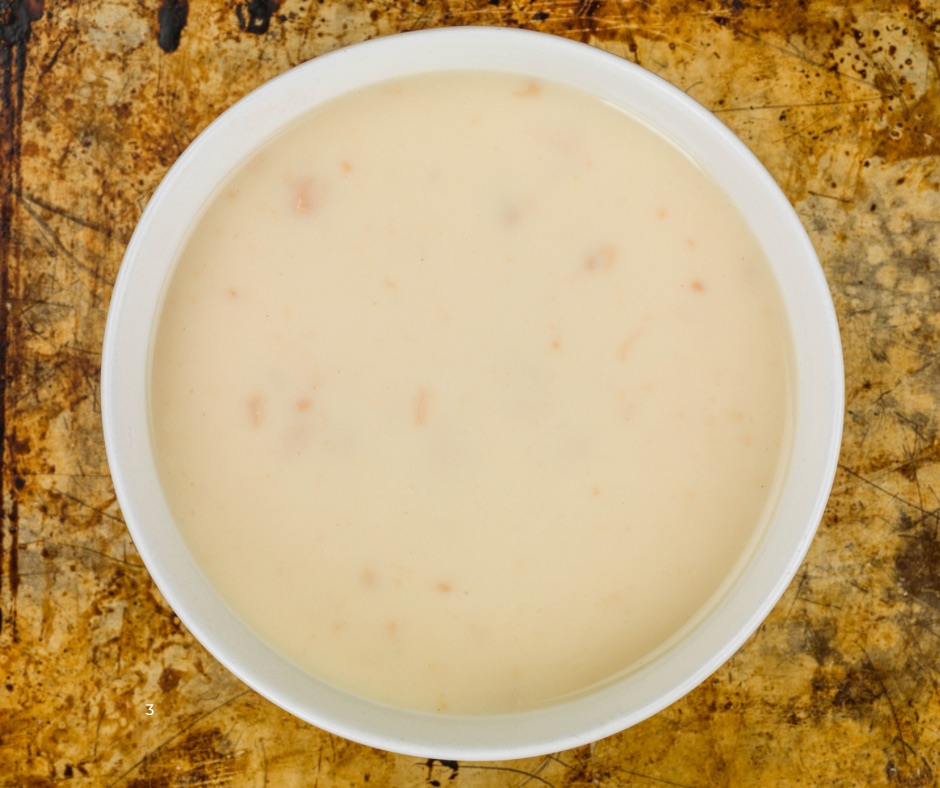You may often turn to cream of chicken soup for a snug comfort food, particularly when you’re not feeling your best.
But does it suffice as a solo dish?
In this article, we’ll find out if you can eat cream of chicken soup by itself and also uncover some of its nutritional benefits as well as delightful add-ons that can turn it from simple and bland to delicious.

Can You Eat Cream Of Chicken Soup Straight From The Can, By Itself?
Absolutely. You can treat yourself to cream of chicken soup straight from the can.
If you prefer your soup warm or hot, simply pour it into a microwave-safe bowl or saucepan before heating since the cans aren’t fit for microwaves due to their metal lining which could cause electric arcs.
The reason why you can eat cream of chicken soup straight out of the can is because it has undergone a rigorous canning process designed to annihilate any bacteria or harmful micro-organisms lurking within.
This assures that your soup is perfectly safe to consume as soon as you pop open the lid!
But make sure to watch out for abnormal signs on your canned goods.
Bulging lids or visible rust and leakage could be red flags pointing towards contamination.
In these cases, it’s better to err on the side of caution and skip the soup.
Can You Eat Cream Of Chicken Soup Cold?
I mean, it’s canned, and technically, it’s safe to consume right out of the packaging, cold!
That said, consuming cold cream of chicken soup might not be everyone’s cup of…well, soup.
Heating your cream of chicken soup is so much more than just raising its temperature.
It amplifies the flavor and enhances the aroma, making each spoonful a savory experience.
Moreover, if you’re feeling under the weather or just need some comfort food on a nippy day – a warm bowl might just be what you need.
Also, just in case you accidentally ended up snacking on a can with buldging or open ends, the heating process can help kill off any pathogens that have found their way in during storage or handling.
For homemade cream of chicken soup however, that’s a different story.
As it isn’t sealed like its canned counterpart, bacteria might sneak their way in during storage.
Hence before indulging in it, ensure to reheat it to an internal temperature of 165°F (74°C) – a temperature at which most bacteria are killed off.
Is Cream Of Chicken Soup Easy To Digest?
It’s critical to realize that the digestibility of this type of soup totally depends on its composition, mainly concerning fat and seasonings involved.
Cream of chicken soup can be light on the stomach if it’s low in fat and subtly seasoned.
However, if this comforting bowl is laden with high fat or heavily spiced, it could potentially become your digestive system’s nemesis.
Fat, despite being an essential nutrient, can decelerate digestion leading to uncomfortable bloating, gas or even diarrhea for some people.
If you’re prone to a sensitive gut or stomach-related ailments, opting for a low-fat rendition of cream of chicken soup might be best for you.
Consider making your own version at home with skim milk or broth as a healthier alternative to the rich cream.
As delightful as spices and seasonings may be — bringing depth in flavor and delightful aroma to your soup — they could end up causing quite a stir in your stomach.
Spices have been reported to irritate the stomach lining or set off acid reflux in certain individuals.
What Are The Benefits Of Cream Of Chicken Soup?
First, cream of chicken soup is primarily composed of liquid which means it aids in hydration.
This benefit comes especially in handy during sickness or dehydration episodes where maintaining fluid balance in the body becomes crucial.
Not just thirst-quenching, it might even be your unexpected ally during bouts of diarrhea.
It’s not all about hydration, though.
This creamy delight can also double as an anti-inflammatory agent, easing symptoms from upper respiratory tract infections like stuffed noses and sore throats.
How so?
It curtails the actions of certain white blood cells called neutrophils that play key roles in inflammation and mucus production.
On top of that, cream of chicken soup is filled with nutrients— proteins, carbs, fats, vitamins, minerals and even collagen to help bolster your overall health.
These vital nutrients support everything from your skin to your bones to your immune system.
However, bear in mind that the nutritional content can vary based on ingredients used and serving sizes.
And then lastly, as we’ve already hinted at the start, one cannot overlook the psychological and emotional benefits that come with a bowl of cream of chicken soup.
It’s not just food—it symbolizes warmth, comfort, nostalgia; an endearing linkage to childhood memories or family traditions.
However prudent it is to reap these impressive benefits, caution against potential drawbacks is worthwhile too.
Nitpicking reveals high sodium content or excessive fats or calories in some versions that could be detrimental for your health if consumed unchecked.
The trick lies in smart choices — opt for low-sodium or low-fat alternatives whenever you can.
Some homemade recipes also cut back on additives significantly making them a healthier option.
What Is The Nutritional Content Of Cream Of Chicken Soup?
For a single serving size of 1 cup (around 252g or 4fl oz) of cream of chicken soup, here’s what you should expect:
- Calories: 226
- Fat: 14.6g, which is approximately 19% of the daily recommended value.
- Cholesterol: A rather modest 7 mg constituting about 7% of your daily quota.
- Sodium: Watch out for a whopping 1770 mg sodium – nearly 77% of your recommended daily limit!
- Protein: A modest protein content with approximately 6g per serving.
- Iron: Adds up to roughly about 14% of your daily value with its contribution standing at 2.6mg.
Going through these numbers, it becomes evident that cream of chicken soup ranks high in calories, fat and sodium.
On the converse, it falls short in fiber and protein content.
It may not strike as the most balanced meal option given its nutritional framework.
But don’t fret if you’re a fan – there are ways to make this goodie soup healthier!
You could dilute it with water or low-sodium broth which invariably brings down per serving calories, fat and sodium content.
Introduce vegetables like carrots or spinach into the mix to up the fiber, vitamins and mineral content.
Boost the protein quotient by adding lean proteins such as turkey or tofu; this would also serve to increase satiety levels.
You could switch regular cream for low-fat or fat-free alternatives to cut back on fat and calorie content.
Lastly, cut back on salt by using herbs and spices for enhancing flavor instead.
What To Eat With Cream Of Chicken Soup?
There are many ways to eat cream of chicken soup and here are some of them.
- Pair with your favorite chips, crunchy crackers, freshly-baked breadsticks or assorted veggies. It adds a hearty richness that elevates your regular snack break into something more decadent.
- Use it as a delicious sauce or gravy to amp up your main dishes like juicy chicken breasts, savory beef chops, classic meatballs, or traditional Salisbury steak. Cover these proteins in this creamy stuff to add depth to your mains.
- Serve cream of chicken soup over fluffy rice, creamy mashed potatoes, al dente noodles or freshly baked biscuits; This versatile soup acts like a velvety blanket providing warmth and comfort to your favorite carbs.
- Use cream of chicken soup as the base in your casserole! It brings the added benefit of binding your ingredients together while adding a dimension of flavor that will impress anyone at the dinner table.
- Warm up some cream of chicken soup and toss in additional vegetables like carrots or celery. Throw in some peas for sweetness or spinach for extra vitamin K. Add pieces of tender chicken or turkey for even more protein – tofu makes an excellent substitute too!

